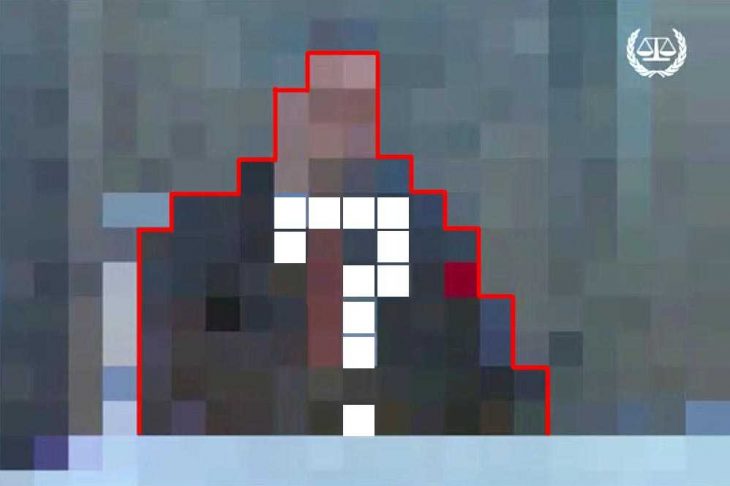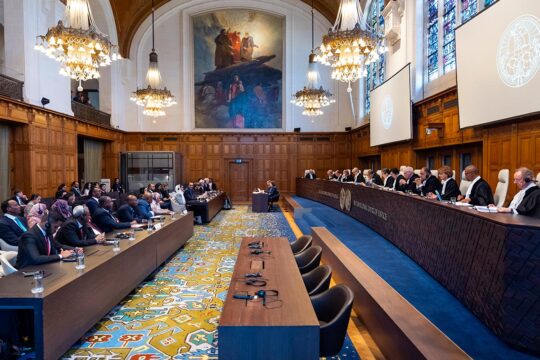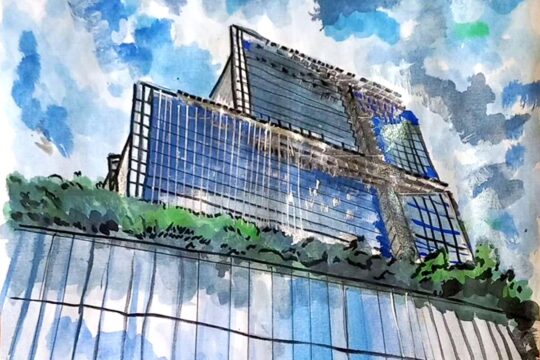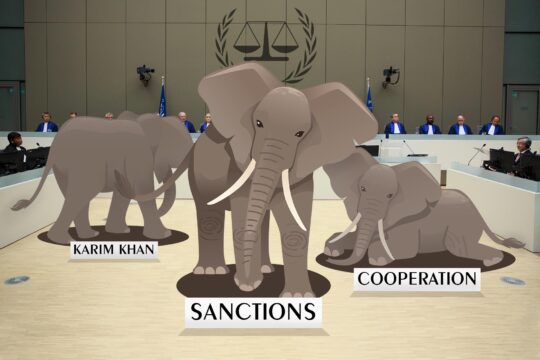“There is risk of identifying the expert – private session please,” sighed presiding judge Antoine Kesia-Mbe Mindua on 15 October. It was the end of the first block of expert testimony in the trial of Al Hassan Ag Abdoul Aziz Ag Mohamed Ag Mahmoud before the International Criminal Court (ICC). Al Hassan is on trial for 7-year-old atrocity crimes in Timbuktu, Mali, nearly six thousand kilometres away from the seat of the ICC in The Hague, The Netherlands.
Zapping between the channels of the ICC courtroom, video-links, private and public sessions, judges have now heard the first fifteen prosecution witnesses. It is laudable that evidentiary examinations take place at all against the uncertain odds of the COVID-19 pandemic. But their substance and significance are obscure. The extraordinary anonymity of experts and confidentiality of their reports render the trial inaccessible, while the sole reliance on European journalists and experts to bring evidence distances the case even further from the Sahel, where the crimes occurred.
The trial of Al Hassan signals a new step in the deteriorating public visibility of international criminal trials. Twice quarantined, from outside and from within, this hermetically sealed justice further disables the impact and meaning the Court could actually have.
Flipping between test screens
Mindua’s protection order has been a repetitive refrain in the trial, often disrupting the Court’s judicial ritual. The Court’s web stream went black for several minutes. Again. Before it suddenly popped back up, showing Al Hassan’s lawyer finishing to put some puzzling forensic proposition: “Would you agree, Mr. Witness?” Ninety seconds later, midway through the expert witness' answer, it flipped back to test screen: “Closed or Private Session.”
Clearly, the Congolese judge was not a fan of this. The day before, prior to the Prosecution’s examination of another shielded expert (“P-0653”), he had urged again the parties to “respect as much as possible the publicity of the proceedings.” But to no avail. What the audience finally got to see from the last witness (“P-0655”) through a pixelated image was a white French-speaking man, whose expertise is to isolate and recognise voices on videos. We were, however, not allowed to see the videos he had analysed, nor to hear Al Hassan’s voice on the recording. Neither were we told what stringent security reasons legitimised this scholar’s cover and the confidentiality of his report.
What or to whom would it be risky to have an open session?
What the ICC preaches and what it actually practices
Six weeks into the Prosecution’s presentation of evidence, the Al Hassan trial is as invisible in Mali as it is to patient ICC observers. Despite handling two Twitter accounts (English and French) serving over 460.000 followers, the Court’s outreach department has cared to tweet about Al Hassan’s case only three times. For a while before the trial’s start on 14 July the Defence team was a solitary online source of information. The Trial Chamber did raise concerns with the Registry over the dearth in exposure, but there were no palpable improvements made towards updating the public about who testified about what, when, from where and why. No one bothered to explain in everyday language the relevance of certain testimony, or to announce who was going to testify. It did not help that the first prosecution witness bluntly told the Trial Chamber that he was “surprised” he had to testify.
What the trial reveals is a world’s difference between what the ICC preaches and promises, and what it actually practices and provides. During opening statements in July, lead prosecutor Gilles Dutertre stressed Timbuktians’ “thirst for justice” and that they “seek to drink the warm and soothing milk of truth”. He and his team narrated a compelling, clear and comprehensible case against a hands-on culprit. Yet today Malians are left out to dry in the desert. The Office of the Prosecutor is missing out on a major opportunity to show affected communities they have a winnable and robust case on their hands. The trial has so far fallen short on delivering beyond what was already generally known.
Al Hassan, “the acting and thinking embodiment of the Islamic police”
The crime scene in the Al Hassan case is Timbuktu and its periphery, when the ancient city was subdued by Ansar Dine, a local franchise of Al-Qaida in the Islamic Maghreb (AQIM). In the group’s short-lived mini-caliphate (April 2012-January 2013), residents were forbidden to drink alcohol, smoke cigarettes, listen to Mali’s mesmerising blues. People were dictated what to wear, how to behave and in what manner to revere Allah. Women were especially dehumanised, relegated to rightless residents. Ansar Dine’s judges ordered girls to obey and satisfy ‘their’ designated men during arranged one-night marriages. In its deviant imagination of Islamist transitional justice, Ansar Dine’s iconoclastic men crushed mausoleums, smashed mosques and scorched books. Griots, librarians and musicians were persecuted. Ansar Dine’s enforcers of Sharia laws were the morality brigade (the Hisbah) and the Islamic Police. Patrolling private and public spaces, fanatic young turbaned men meted out unforgiving penances: public humiliation, fines, detention, amputation, flogging, stoning. And their “zealous commissioner”, alleges the Prosecution, was Al Hassan.
At the heart of the case, said Chief Prosecutor Fatou Bensouda during her one-day trial attendance on 14 July, is “a veritable persecution on religious and gender grounds” at the hands of Ansar Dine and AQIM. Al Hassan, who she contended was “the acting and thinking embodiment of the Islamic police”, was “a willing perpetrator and member of this organisation from the very outset.” Through his appearance in international media in 2013, Al Hassan was indeed an identifiable and prosecutable target for investigators. Already jailed in a Malian prison, he was also a convenient suspect and defendant. However, in the pool of potential Ansar Dine or AQIM suspects – including Ansar Dine’s headman Iyad Ag Ghaly – Al Hassan is a mid-size “fish”. An insignificant veterinary pharmacist in his mid-thirties, he turned into an extremist under extraordinary circumstances. His lawyers now portray him as a torture victim – unfit to stand trial, and suffering from post-traumatic stress disorder.
Self-incriminating evidence
Hiding his face under his turban and behind glasses and a protective mask, the accused silently observes how foreigners talk about his home country. Looking somewhat unemotional, he hears how the thirteen counts of crimes against humanity and war crimes levelled against him may actually represent the totality of Ansar Dine’s ten-month reign: widespread and systematic torture, forced marriages, sexual slavery, rape, persecution, cruel treatments, outrages upon personal dignity, passing sentences without judgement, attacking protected monuments, and several other inhumane acts. Without revealing details, Bensouda said “the suffering endured by Timbuktu and its inhabitants is emblematic of what happened.” It took the Trial Chamber 43 minutes to read out the charges – in closed session.
Despite the heavily redacted charges, we did get a glimpse of the evidence that puts Al Hassan at the centre of the crime scene. While detained by Mali’s General Directorate of State Security, Al Hassan had been extensively quizzed by ICC investigators. One of the things he admitted was that it was his private mobile phone number on a plaque that hung on the Islamic Police’s headquarters’ façade. Then there are videos. On one, he explains the Islamic police’s tasks and work. On another, he strolls the streets of Timbuktu, wearing a yellow turban and a blue smock bearing the words “Police Islamique”. Most explicit is a short film of Al Hassan whipping two men on their backs, bottoms and legs. In addition to this material there is a thick binder of documents, many of which were photographed or smuggled out of Mali by international journalists (including by the first two witnesses). They include incriminating police reports with Al Hassan’s signature on them.
The Prosecution also has a crucial insider in its custody: Ahmed Al Faqi Al Mahdi. This fellow Ansar Dine associate entered into an agreement with the ICC Prosecutor in February 2016, admitting guilt for destroying and damaging ancient mausoleums and a mosque in Timbuktu. He is now serving a nine-year prison sentence in the United Kingdom, and he is expected to testify against his alleged former partner in crime. Yet, it remains unclear when the ‘star witness’ will take the stand.

Faceless justice
Much of the trial’s secrecy is officially explained by Mali’s uncertain situation. In early July, the ICC’s Registry reported “armed attacks and abductions” with “extreme threat levels of terrorism and criminality” and “civil unrest.” In August there was another coup d’état in Bamako, Mali’s capital. Meanwhile, Ansar Dine and AQIM purportedly pose dangers to witnesses and victims. One expects a court dealing with atrocities to get caught up in dangerous situations and be worried about safety. But this has now driven the Court into becoming a distant, isolated side-show to real-time theatres of enduring violence – the type the ICC was set up to deter in the first place.
There is no doubt the endless violence in Mali has ruthlessly affected the Court’s investigations and the sequence in which the Prosecution’s evidence could be brought before the Trial Chamber. Most notable is the absence of Malian witnesses. So far, there has not been a coherent trial narrative, with victims’ voices and insiders who could link crimes to the alleged perpetrator in the dock. Instead, all witnesses have been experts and journalists from the global north, mostly from France, Mali’s former coloniser. And whereas one could understand that Timbuktians would request some protective measures, it is perplexing and unprecedented that the majority of these Europeans witnesses have been provided aliases, have their faces and voices distorted and their evidence redacted. After nearly two months of proceedings, the transcripts of only three witnesses have been published; a fourth one was later deleted from the ICC website.
Expert testimony used to be unquestionably public before international tribunals; expert reports were published too. Where has this gone?
Words of foreign journalists
Among the handful unprotected witnesses was Dutch journalist Harald Doornbos. Flown in from the United Arabic Emirates and undergoing four Covid-19 tests, he was the first to take the stand in The Hague. But he had not much to tell, other than that he had found some documents in a bank and in a hotel. Former British journalist David Blair (who now is UK Prime Minister Boris Johnson’s speechwriter), the second witness, had also reported from Mali. In 2013, he broke a story in the Daily Telegraph about a secret document he and photographer Will Wintercross had found and taken from Timbuktu to London. It concerned the record of the 33rd meeting of AQIM’s leadership, highlighting “the names of the leaders”, describing “their plans” as to what “they intended to do once they had captured northern Mali.” But the Prosecution did not press on the contents of the document at all. Rather it was interested in showing judges how Blair gave it to ICC investigators through a clear chain of custody.
Three experts who also worked or previously testified for the Prosecution appeared publicly. Xavier Laroche, who works with the UN’s Investigative Team to Promote Accountability for Crimes Committed by Da'esh/ISIL (UNITAD), analysed and wrote a report on the China-made Kalashnikovs used by Ansar Dine’s policemen. Lars Bromley, from the United Nations Institute for Training and Research, briefly testified about satellite imagery of Timbuktu, highlighting places were building were altered or damaged. Francesco Bandarin, UNESCO’s former Assistant Director-General for Culture, speculated on the impact the destruction of Timbuktu’s historical heritage had on Timbuktians but referred the judges to the testimony he had already given in the Al Mahdi trial.
Another journalist may have had more interesting things to say, since she had interviewed Al Hassan several times during Timbuktu’s occupation. Testifying in English, she however preferred to be referred to as “P-0623” and be mostly examined in private session. Speaking in a clear Irish accent was the seventh witness, whose alias the chamber omitted to reveal. He is another former journalist who has joined the ICC Prosecution as an associate investigator in 2014, becoming the Office’s geo-location expert. Questioned by his colleagues, he was confident about his report on protected sites in Timbuktu.
Who is the trial for?
Overall, expert testimony was more technical than substantial. Both parties avoided questions that might throw them into private session, turning the live sessions into a superficial experience. This modus operandi has made it even more difficult to basically grasp, let alone get under the skin of, any of the evidence given by the anonymous experts, including about Mali’s mausoleums, Ansar Dine and AQIM’s documents and digital data, as well as Al Hassan’s handwriting, signature, facial recognition and voice recognition. Apart from a protected forensic police inspector (“P-0057”) who had been seconded to the Prosecution by the French government (which is fighting Jihadists in Mali and the region), it is a largely unsolved mystery why these experts requested (or were offered) and were granted protective measures. Even the most substantive, least boring witness (“P-0152”), who sharply educated the ICC judges about the history of Mali’s conflict and its most important players, chose some protective measures. Testifying with his name withheld, the European political scientist did explain that he was concerned with the security of his Malian colleagues if it would be known they are closely working with an international researcher who gave evidence in this case.
It is hard to assess whether concerns over non-Malian expert witnesses’ exposure in Mali are well-founded. But it is unlikely that the Office of the Prosecutor will move from its chosen path of secrecy. In comprehensively censored filings, it has proposed another ten experts on topics that are redacted. Its reasons may sometimes be understandable, particularly when it comes to witnesses on the ground. But because of the redactions it is not known if this even applies to the next round of expert testimony. The impression left is that the ICC has already forgotten about its claimed audience: victims.
It begs the question: who else than affected communities is international justice primarily for?
The problem of moving further away from public trials and lacking engagement with society beyond the “high-level” and academic bubbles is systemic at international tribunals. The Al Hassan trial rings an alarm on whether this is how future trials will look – irreversibly out of reach.
The way to go
It may not be too late to turn the tide. There is quite simply a world to win for the ICC as a whole, if only it changes the way in which it presents itself and starts providing meaning to its actual audiences, like the inhabitants of Timbuktu. In his book, “Justice as a Message”, international law professor Carsten Stahn, saliently portrays how such an ideal could look. “Trials”, he writes, “entail a whole range of messages that extend beyond punishment. They ‘speak’ to the citizens as members of the normative community. They serve to reinforce belief in the validity of norms, articulate the public understanding of the acts of the perpetrator, and to engage the offender, the victim, and society in discourse over wrongdoing. The judgement is essentially a reasoned public speech act.” In order for that to materialise and work in Mali, the Al Hassan trial must be de-quarantined. As the Trial Chamber prepares for next week’s apparently crucial witness – “P-0065”, one of the longest-awaited testimony – there is no reason why it should not step up to spark such a metamorphosis.
 THIJS BOUWKNEGT
THIJS BOUWKNEGT
Thijs Bouwknegt is a historian and former journalist. He is a Researcher at the NIOD Institute for War, Holocaust and Genocide Studies in Amsterdam, The Netherlands, and Assistant Professor at the universities of Amsterdam and Leiden. His research focuses on the history of transitional justice, particularly in Africa. Since 2006, he attended and covered all ICC (pre-) trials in The Hague.






